mobile View, to the German Version tap the flag


- State of Kuwait
- absolute monarchy (emirate) with initial stages of parliamentarism
- zone of US-american influence
- own name: Dawlat al-Kuwajt
• Flags
• Historical Flags
• Meaning/Origin of the Flag
• Coat of Arms
• Meaning/Origin of the Coat of Arms
• Aircraft Roundel
• Map
• Numbers and Facts
• History
• Origin of the Country's Name
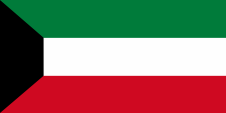
since 1961,
National flag,
ratio = 1:2,
Source, by: Wikipedia (D)





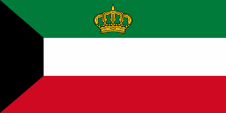
since 1961,
Flag of the Emir,
ratio = 1:2,
Source, by: Wikipedia (EN), Flag_of_Kuwait.svg:
SKoppderivative work: Fry1989 (talk) 23:22, 3 February 2011 (UTC),
Public domain, via Wikimedia Commons





to 1899,
National flag,
Source, by: Flags of the World



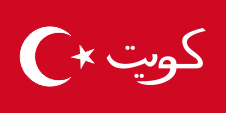
1899–1909,
National flag,
Source, by: Wikipedia (DE)



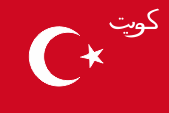
1909–1915,
National flag,
Source, by: Wikipedia (DE)



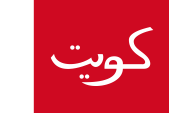
1915–1956,
National flag,
Source, by: Wikipedia (DE)



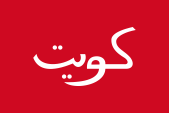
1915–1956, –1961,
National flag,
Source, by: Flags of the World



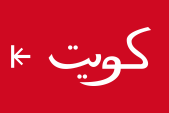
1915–1956,
National flag,
Variante,
Source, by: Die Welt im bunten Flaggenbild



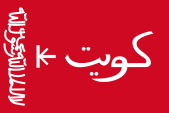
1956,
Flag of the Sheikh,
Source, by: Wikipedia (DE)



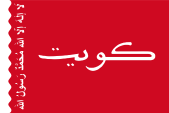
1956–1961,
National flag,
Source, by: Wikipedia (DE)




The today's flag of Kuwait shows three horizontal stripes in green, white and red with a black trapezoid on the leech. It was introduced by a decree of the Emir on the 7th of September in 1961. Green stands for the fields, the agriculture and the vegetation of the country. White stands for virtue, purity, peace and honor. Red stands for courage und valor but also for the blood of the enemies. Black stands for the by Kuwaiti horseman whirled sand of the battlefields. The colour quartet of four, green, white, black and red is a special Arabian colours symbol, the Panarabian colours. The (Pan)Arabian colours were officially introduced by the Sheriff Hussein of Mekka – of the lineage of the Hashemides – as colours of the Arabian Movement during the First World War at the secession of the Kingdom of Hedjas from the Ottoman Empire. The flag of Hedjas served as pattern. The colours have the following meaning: Red is the colour of Omar, the second calif; white stands for the Omajiades, a calif-dynasty, which goes back to the fifth calif Moawija I.; green stands for the Fatimides, a ismailitic-shiit calif-dynasty, which goes back to the fourth calif Ali; and black stands for the Abbasides, a calif-dynasty, which goes back to the calif Abbas I. Red is also the colour of the Hashemides, an Arabian sovereign-dynasty, which probably goes back to Hashim ibn Abd al-Manaf, the grandfather of Mohammed. Green is in addition generally the colour of Islam, and does not refer only to the Arabian countries. The flag-history of Kuwait before 1961 is quite mazy, because there are no clear sources about that. Renowned authors of flag-literature gainsaying in this point exactly like appropriate web pages. The following facts are to take nearly doubtless from the available material: The city of Kuwait was conquered by the Ottoman Empire in 1638, but the local ruling dynasty of the Bani Khalid remained in power, who founded the Sheikhdom of Kuwait in 1710 in recognition of Turkish sovereignty. The present dynasty of the al-Sabah family came to power in 1756. In 1962, the country became an emirate. The old sheikhdom, like other sheikhdoms in the Gulf region, seems to have used a monochrome red flag, at least until 1899. After that, the name of the country and half-moon and star were placed on the flag. The latter is the symbolism of the Ottoman Empire, under whose supremacy Kuwait was, which was evidently evident on the flag under growing British influence. After the British protectorate was established, half-moon and star were removed from the flag and a white stripe was added to the mast, as was the case with almost all the sheikhdoms of the Gulf region that were under the protectorate of United Kingdom. Later, the strip was often omitted, sometimes a small arrow added, the symbol of the al-Sabah family. In 1956, a new flag was introduced showing the white stripe, but delineated with a wave line to the red field. Then there was the shahada, the Islamic creed that appeared along the white stripe on the red cloth, which still showed the name of the country in the middle. In practice, however, the old flags were reused until the introduction of the present flag, probably the model withe the shahada was too difficult to produce. Red is in the region of the Indian Ocean a flag color with a great tradition and is widely used, from the coasts of Arabia, to Zansibar, and to the Maldives. It is closely connected to Islam, because red is the colour: 1st) of the Sherifs of Mecca, 2nd) of the Charidshites and Ibadites, and 3rd) of the descendants of the Calif Ali.
Source:
Wikipedia (D),
Die Welt der Flaggen,
Flaggen Wappen Hymnen,
Die Welt im bunten Flaggenbild,
Flaggen Enzyklopädie

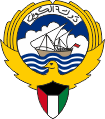
Coat of arms of Kuwait,
Source: Corel Draw 4

The coat of arms shows a hawk with outspread wings and a flag-blazon on the chest. Above that, within the wings, a disk with a sea scene and a traditional Dhau (sailing ship) with a red flag on the stern. In the upper border a white banner with the Arabic inscription "Dawlat al Kuwait" (State of Kuwait).
Source:
Flaggen Wappen Hymnen


Aircraft Roundel,
Source, by: Wikipedia (EN)

Location:
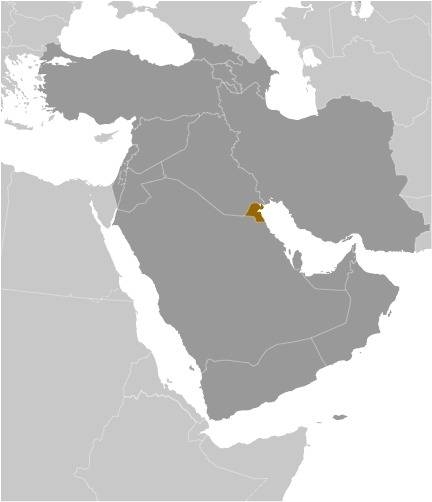
Source: CIA World Factbook
Map of the country:
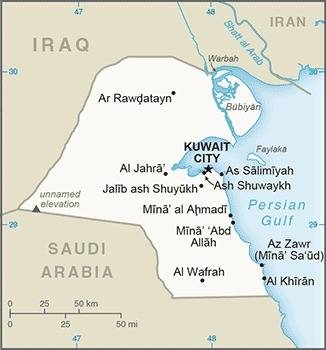
Source: CIA World Factbook

Area: 6.880 square miles
Inhabitants: 4.300.000 (2020), thereof 30% Kuwaiti citizens (Arabs), 27% foreign Arabs, 40% Asian
Religions: 75% Muslim, 18% Christian
Density of Population: 625 inh./sq.mi.
Capital: al-Kuwait (Kuwait City), 2.989.000 inh. (2018)
official Language: Arabic
other Languages: English
Currency: 1 Kuwait Dinar (KWD, KD) = 10 Dirham (= 1000 Fils)
Time Zone: GMT + 3 h
Source:
Wikipedia (D),
CIA World Factbook

656 · conquest by the Arabic Califate, Islamization
1555 · the place Kuwait is captured by the Ottoman Empire erobert, but afterward given up
1638 · the by the family Bani Khalid ruled Kuwait is captured again by the Ottoman Empire and incorporated only formally to the Province of Basra, the Bani Khalid stay the masters of the city
1710 · official foundation of the Sheikdom of Kuwait by furthermore acceptance of the Turkish supremacy
1756 · the family al-Sabah comes to power in Kuwait and becomes the ruling dynasty
1793 · United Kingdom relocates the trade office of this region from Basra to Kuwait
1796 · United Kingdom relocates back the trade office from Kuwait to Basra
1821 · United Kingdom relocates again and now ultimately its trade office from Basra to Kuweit
1829 · to push back the influence of United Kingdom the Ottoman Empire incorporates Kuwait officially to the Province of Basra, but grants partial autonomy
1899 · secret treaty between Kuwait and United Kingdom for preservation of the British interests
1902 · growing influence of the Ottoman Empire and of the German Empire, United Kingdom has to retreat from Kuwait
1903 · one German warship docks in Kuwait
1904 · United Kingdom subordinates Kuwait its influence again by a counsellor
1906 · United Kingdom establishs its protectorate over Kuwait, not recognized by the Ottoman Empire
29th of May 1913 · the Ottoman Empire recognizes the British protectorate
13th of November 1914 · new treaty of protectorate between Kuwait and United Kingdom under granting of autonomy
1922 · first finding of mineral oil, because of frontier quarrels in the oil area Kuwait and Saudi Arabia agree upon a Neutral Zone (ca. 2 120 sq.mi.)
19th of June 1961 · end of the British protectorate, independence, Iraq demands Kuwait as a part of the Province of Basra
1962 · new constitution, Kuwait becomes an Emirate
1963 · Iraq recognizes Kuwait
1966 · the Neutral Zone stands (till today), but becomes divided in a Saudi and in a Kuwaiti administrative district
1990 · Iraq annexes Kuwait
1991 · Kuwait becomes conquered back by US-American and British troops (Second Gulf War)
2003 · Kuwait is the main base for troops of the USA to invade Iraq (Third Gulf War)
Source:
Atlas zur Geschichte,
Wikipedia (D),
Discovery '97

The name of the country goes logically back to the city of "Kuweit". "Kuweit" is Arabic and means "enclosed village".
Source: Handbuch der geographischen Namen


![]()

































